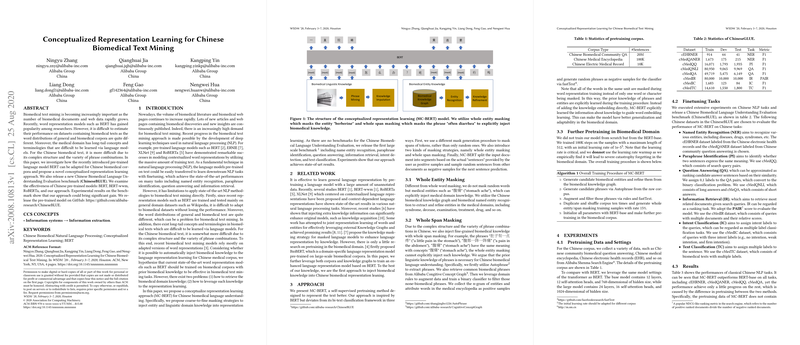Conceptualized Representation Learning for Chinese Biomedical Text Mining
The paper "Conceptualized Representation Learning for Chinese Biomedical Text Mining" presents a novel approach to enhancing the performance of pre-trained LLMs, specifically BERT, within the context of Chinese biomedical text mining. The authors recognize the distinct challenges presented by this domain, including complex language structures and the long-tail distributions of biomedical concepts, which are not adequately addressed by models trained on general corpus data.
Core Contributions
The paper puts forth a conceptualized representation learning approach designed to infuse biomedical knowledge into pre-trained LLMs. The authors employ a sophisticated masking strategy, termed "coarse-to-fine masking," which includes whole entity masking and whole span masking. These strategies explicitly incorporate biomedical knowledge into the model, thereby improving its ability to capture and utilize domain-specific information.
Additionally, the paper introduces the Chinese Biomedical Language Understanding Evaluation benchmark, known as ChineseBLUE. This benchmark serves as the foundation for evaluating the performance of various Chinese pre-trained models, including BERT, BERT-wwm, RoBERTa, and the proposed approach.
Experimental Methodology and Results
The proposed model, MC-BERT, is pre-trained on a diverse set of Chinese biomedical datasets. It employs whole entity masking to obscure medical entities and whole span masking for Chinese phrases to incorporate linguistic and domain knowledge into the model’s training. The approach is benchmarked against several NLP tasks, including named entity recognition (NER), paraphrase identification, question answering, information retrieval, intent classification, and text classification.
Results indicate that MC-BERT significantly outperforms BERT-base models across all tasks in the ChineseBLUE benchmark. Notably, enhancements in named entity recognition and paraphrase identification demonstrate the efficacy of integrating domain knowledge into pre-trained models. The performance gains achieved by MC-BERT are particularly noteworthy, presenting an advancement over existing Chinese pre-trained models such as BERT-wwm and RoBERTa, thus affirming the importance of domain-specific training.
Implications and Future Directions
The approach delineated in this paper underscores the significance of domain-adapted pre-training for NLP models, particularly in fields characterized by specialized terminology and complex language structures, such as biomedical text mining. By introducing a domain-specific evaluation benchmark, ChineseBLUE, the authors provide a valuable resource for the further development and assessment of models within this crucial area.
Practically, the approach facilitates more accurate and efficient biomedical information retrieval and analysis, which is essential for practitioners and researchers in the biomedical field. Theoretically, the work contributes to the broader understanding of how domain knowledge can be systematically and effectively embedded into LLMs.
Future research could explore the adaptation of this approach to other language domains or the incorporation of concept-level knowledge into the model. Greater exploration into corpus diversity and its effects on model adaptability can also offer insights into pre-trained model optimization.
In conclusion, the paper offers a robust framework for improving the adaptability of pre-trained LLMs to specialized domains, a step forward in the growing field of biomedical NLP.
